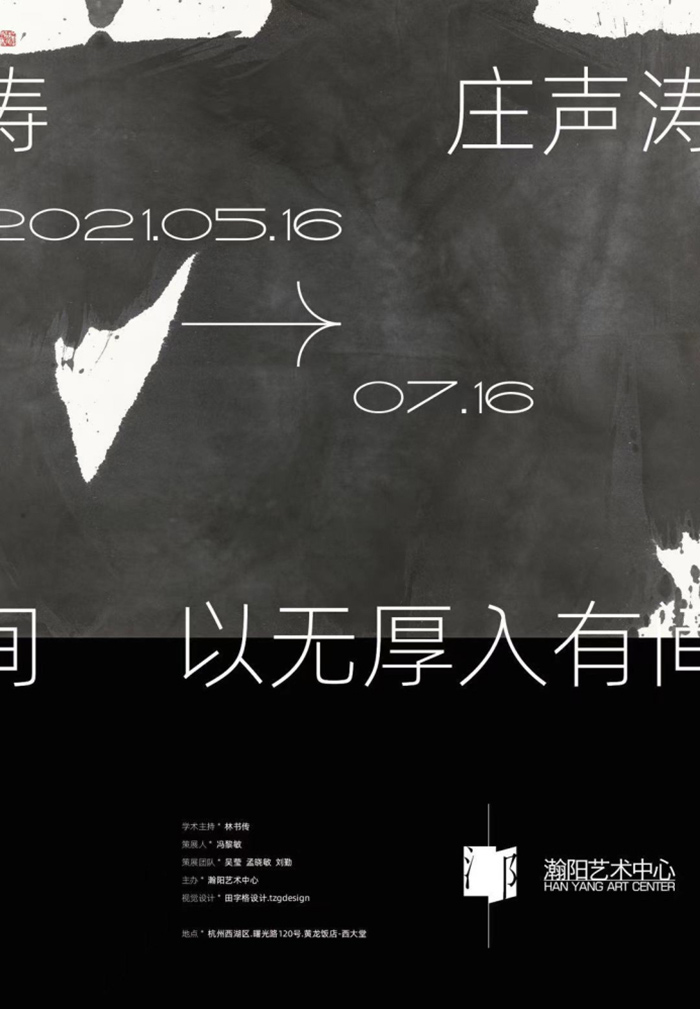
展覽海報(bào)
展覽名稱:以無厚入有間——莊聲濤先生個(gè)展
學(xué)術(shù)主持:林書傳
策展人:馮黎敏
展覽時(shí)間:2021.5.16-6.16
主辦單位:瀚陽藝術(shù)中心
視覺設(shè)計(jì):田字格設(shè)計(jì) tzgdesign
展覽地點(diǎn):杭州西湖區(qū)曙光路120號(hào),黃龍飯店西大堂
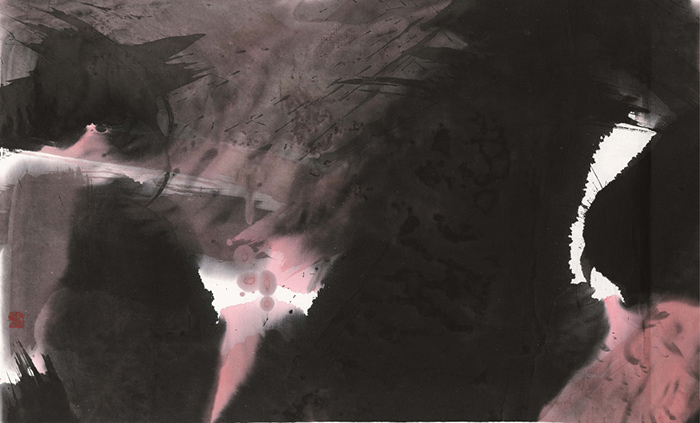
“山水” 色-墨-宣紙-47x78cm 2014
以無厚入有間
莊聲濤先生的作品,大都筆勢(shì)赫奕、生氣淋漓,雖以傳統(tǒng)筆墨入畫,卻能煥然而出一股騰挪跌宕的不羈之力,雖有落拓恣意的逍遙風(fēng)骨,卻無半點(diǎn)佯狂放浪的習(xí)氣,雖飽納江南氤氳鐘靈,卻斷無鄉(xiāng)愿遺俗的曲逢。在東方與西方之間,在傳統(tǒng)與當(dāng)代之間,在生活與創(chuàng)作之間,他以無厚入有間的篤定,形貌巋然,自成乾坤。
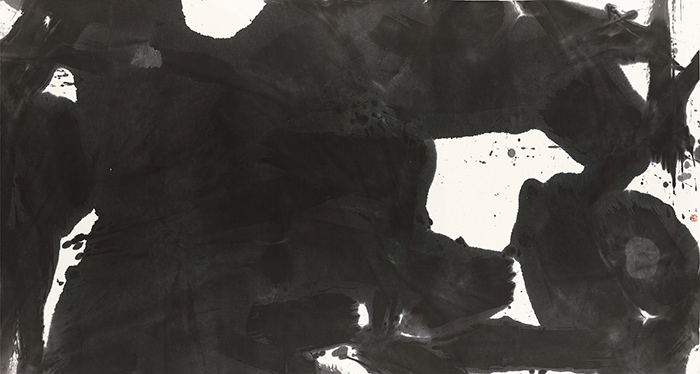
“荷塘 1” 墨-宣紙 96x180cm-2008
所謂“以無厚入有間”,語出莊子《庖丁解牛》,故事講的是廚師給梁惠王宰牛,梁惠王問他的技藝怎么竟然高到這種程度,庖丁說:“以無厚入有間,恢恢乎其于游刃必有余地矣,是以十九年而刀刃若新發(fā)于硎”,意思是以薄薄的刀刃進(jìn)入牛骨的間歇,我能夠游刃有余,因?yàn)槭拍陙恚度羞€象剛從磨刀石上磨出來的一樣。這一精妙的回答,一方面彰顯了其高超的技藝,另一方面形象地表達(dá)了“寶刀不老,愈見其利”的狀態(tài)。我之所以用“以無厚入有間”來涵括莊先生的作品,并作為展覽主題,是因?yàn)椋瑹o論是莊先生作為藝術(shù)家,他在作品中表現(xiàn)出的創(chuàng)作狀態(tài),還是作為一個(gè)生命個(gè)體,他在延綿數(shù)十載的時(shí)間軸線上,幾次易地而居,每每在陌生之地所顯豁出的精神狀態(tài),都極具“恢恢乎其于游刃必有余地矣”的特點(diǎn)。

“夜色-1”-墨-宣紙180x96cm-2006

“情動(dòng)于中”-墨-宣紙-100x50cm-2017
東方哲學(xué)講天人合一,西方哲學(xué)講主體客體,前者重感受和頓悟,后者重理性和思辨。莊先生的創(chuàng)作之路,選擇了統(tǒng)納兩者所長,融東方的筆墨意蘊(yùn)和西方的抽象表現(xiàn)于一爐,更關(guān)鍵的是他在本來互不兼容,硬若牛骨的東西方兩套截然有別的美學(xué)系統(tǒng)中,精準(zhǔn)地找到了間隙,并遨游其中。這其中有兩個(gè)方面的原因,為他提供了堅(jiān)固的基礎(chǔ),一個(gè)就是他自幼研習(xí)真草隸篆,深諳筆墨秉性,并進(jìn)而轉(zhuǎn)化為繪畫中的書寫性,這是一個(gè)連貫有序、講求積累玩不得花樣的系統(tǒng)性建構(gòu)。另一個(gè)就是他無論是在東南亞,還是在法蘭西、美利堅(jiān),無論身處何種語境,他都抱元守一,堅(jiān)守東方傳統(tǒng)的筆墨的根性。雖然表面上這兩點(diǎn)有其相似性,即“書寫性”和“筆墨根性”,但在本質(zhì)上卻截然有別。“書寫性”是技法表現(xiàn)層面的表述,而“筆墨根性”卻是形而上的表述,可以簡(jiǎn)單理解為,前者是“術(shù)”,后者是“道”,雖然互相勾連暗通骨血,卻各有所指各有所重。
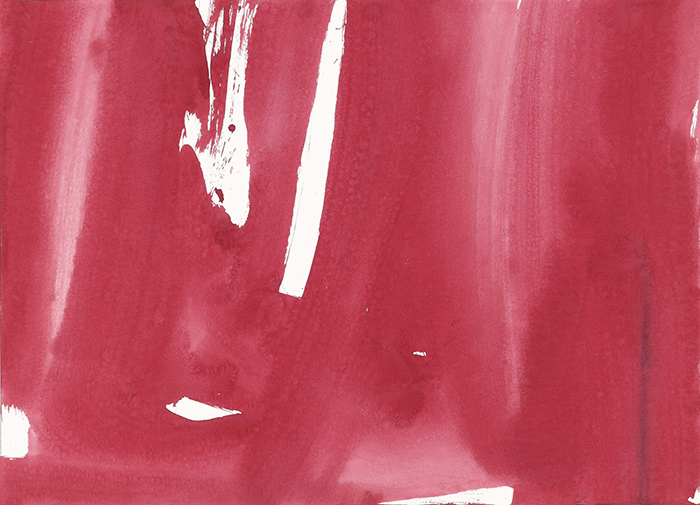
“重彩之大紅”-色-水彩紙- 39x54cm-2019
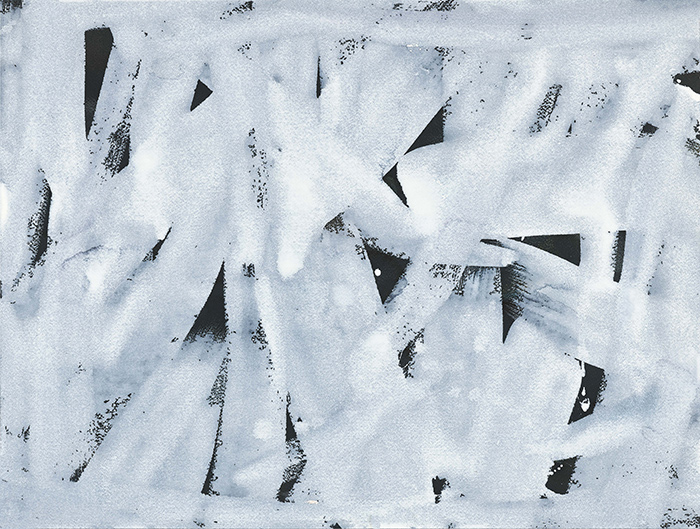
“重彩之粉白” 墨 色 水彩紙 46x61cm 2019
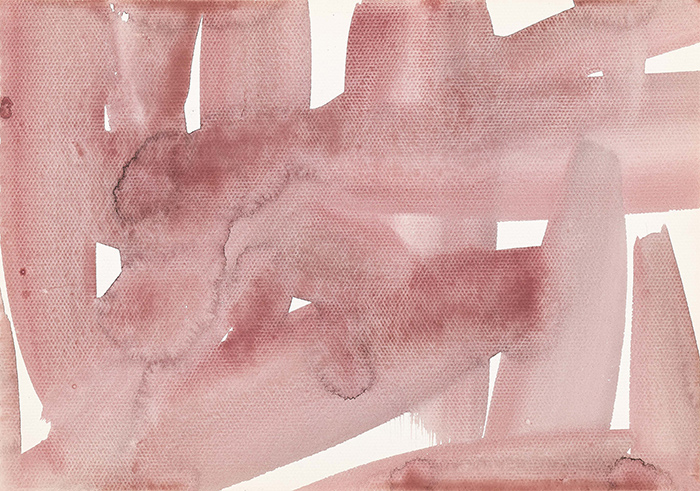
“重彩之桃紅”-色-水彩紙-26x37cm-2019
莊聲濤先生,從7歲起,汲汲于筆墨之道七十余載,其繪畫的技藝、生命的狀態(tài),以及從作品中透射出的精神氣象,都毋庸置疑地堪比莊子筆下“若新發(fā)于硎”的庖丁。“以無厚入有間”既貼切地表明了作為藝術(shù)家的莊聲濤,在東方傳統(tǒng)筆墨的根脈上,矢志彌堅(jiān),同時(shí)他化用西方抽象藝術(shù)的表現(xiàn)形式和構(gòu)圖方法,從容駕馭畫面,每每在筆墨的間隙里,都能赫然有光。隨著光在間隙中的游走,一個(gè)根脈通暢、元?dú)饬芾臁⑿紊耧枬M的藝術(shù)家面貌躍然筆墨之間。他無論是從潮州出發(fā),從新加坡出發(fā),抑或是從蘇州出發(fā),歸根結(jié)蒂,都是從筆墨出發(fā),因而,筆墨里有他的故鄉(xiāng),有他里的潮州、新加坡,有他的蘇州,筆墨里有他洞悉人間世后,“以無厚入有間”的智慧與從容。
——林書傳
2021-5-9
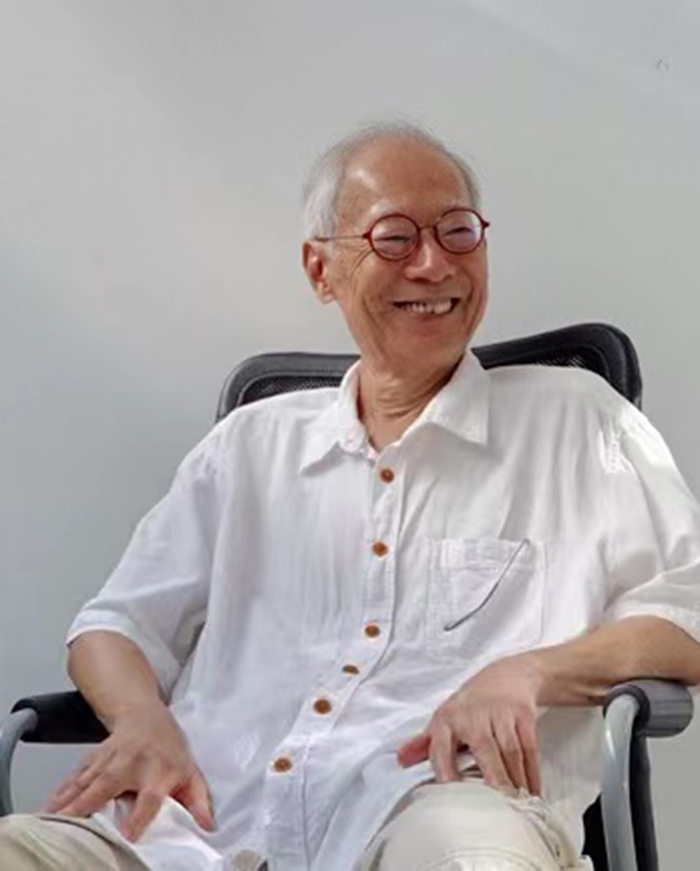
藝術(shù)家莊聲濤
莊聲濤簡(jiǎn)歷
1944 出生于中國
1955 移居新加坡
1964 進(jìn)入南洋美術(shù)專科學(xué)校研究班
向中國書畫名家施香沱先生學(xué)習(xí)書畫
1966 組建旨在推動(dòng)和發(fā)展新加坡的水墨藝術(shù)的年輕團(tuán)體“墨瀾社”
1969 任“新加坡開埠 l50年紀(jì)念美展”的工作委員及“東方美術(shù)組”評(píng)委
1972 獲南洋大學(xué)一等榮譽(yù)文學(xué)士
1977 獲南洋大學(xué)文學(xué)碩士學(xué)位
1979 個(gè)人首次畫展,新加坡希爾頓飯店,新加坡
任新加坡訪華美術(shù)文物考察團(tuán)秘書訪問中國
1980 “第一屆國際書法展”,香港
1981 游學(xué)法國,為期一年
1982 “旅法畫展-莊聲濤個(gè)展”,藝術(shù)之家畫廊,新加坡
“新加坡藝術(shù)節(jié)美展”
第三屆東盟美術(shù)巡回展”
1983 “新加坡畫家三人展”,墨爾本,澳大利亞
1985 “莊聲濤書法近作- 莊聲濤個(gè)展”,新加坡國家博物院,新加坡
1986 “我的道路-莊聲濤個(gè)展”,亞化畫廊,新加坡
1987 “新方向,八十年代新加坡的現(xiàn)代藝術(shù)”,新加坡國家博物院,新加坡
“國家博物院百年紀(jì)念展”,新加坡國家博物院,新加坡
1987.8 前往美國加利福尼亞州
1988.4 北上華盛頓州,入科尼斯藝術(shù)學(xué)院學(xué)習(xí),制作版畫,完成“山的系列”套色木板
1988.9 入華盛頓大學(xué)藝術(shù)院繪畫研究所主修西洋現(xiàn)代藝術(shù),并著手制作系列油、膠彩和拼貼作品
1991 藝術(shù)研究生作品聯(lián)展,華盛頓大學(xué)亨利畫廊,美國
1993 “水墨之旅”,國家博物院畫廊,新加坡
“第二屆東盟藝術(shù)研討會(huì)和作品展”,馬尼拉,菲律賓
1994 “秋思-莊聲濤個(gè)展”,生畫廊,新加坡
1996.10 前往杭州
1997.8 前往蘇州,并客居至今
1999 “Power and Poetry”三人展,新加坡美術(shù)館,新加坡
2006 “第五屆深圳國際水墨雙年展”,關(guān)山月美術(shù)館,中國深圳
2007 “水墨在途——2007上海新水墨大展”,朱屺瞻美術(shù)館,中國上海
2009 蘇州本色美術(shù)館“入駐”藝術(shù)家
2016 “Variation in Ink”莊聲濤回顧展,私人藏家,新加坡
2017 “莊聲濤水墨展”,誰先覺畫廊iPreciation,新加坡
2020 “濃墨重彩-莊聲濤獨(dú)家在線個(gè)展”,誰先覺畫廊iPreciation,新加坡
2021 “楮墨之外——在蘇州”莊聲濤個(gè)展, 誰先覺畫廊 iPreciation,新加坡
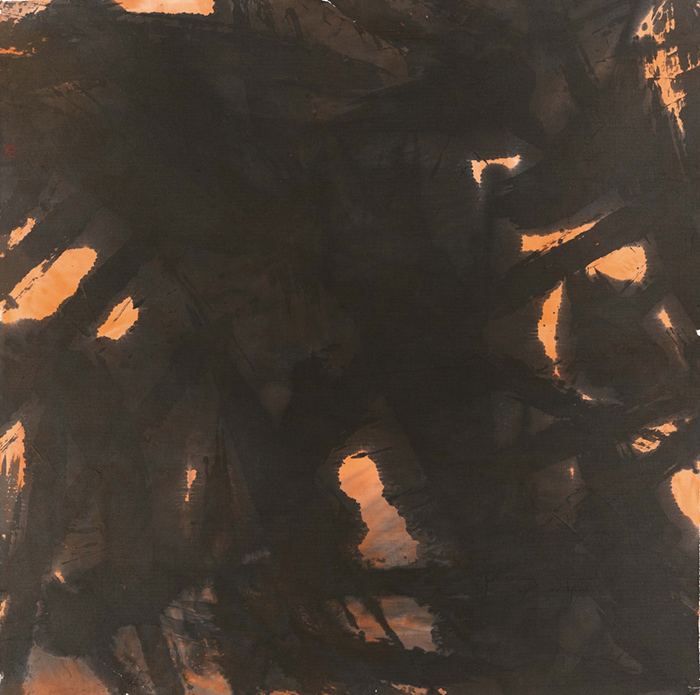
“朱墨-3” 墨-色-宣紙-100x100cm-2016
I rely on Heaven's structuring
The works of Zhuang Shengtao are grand and vivid. Though traditional strokes have been part of his paintings, a bohemian allure emanates from the image that is free and unfettered, without any pretentious wildness. Shaped by the lofty aura exclusive to the regions south of the Yangtze River, these works aren’t done as part of the tacky homesickness. Instead, they drift between the East and the West, transcend modernity and the contemporary, and connect life with creations. In a word, Zhuang is trying to fit for spaces with a calm, uncompromising and heavenly mindset.
According to Zhuangzi’s Dismember an Ox as Skillfully as a Butcher, a butcher named Ding once explained to King Hui of Liang about his high skills of dismembering an ox. Ding said, “The key is to fit my thin blade for the spaces between ox bones, where I can move the blade as I wish because my blade has been in a perfect shape over the past 19 years, just like it’s being recently ground on a stone”. This is a spectacular response that highlights his mastery of sublime skills and demonstrates the fact that “an effective blade never ages but gets ever sharper”. Therefore, I quote from the ancient record and use “Fitting For Spaces” as the catchphrase for Mr. Zhuang’s works and the exhibition. As an artist, Zhuang has been seen as an individual life in his creations, and he has relocated multiple times over decades, no matter where he went, his spiritual status in an unknown place has been reminiscent of “moving a blade as he wishes”.
The philosophical insights in the East put humans as an integral part of nature, but the Western philosophers came up with subjects and objects. Therefore, feelings and sudden enlightenments are highlighted in the East, but rationality and critical thinking in the West. Zhuang, however, has borne both the East and the West in mind for his creations that juxtapose the oriental connotations of strokes with the abstract genre of the West. More importantly, he has been so accurate in locating a comfortable space from the two incompatible and starkly contrasting aesthetic systems. I think two reasons laid a solid foundation for his style. First, he has been studying Chinese calligraphy since childhood and his deep understanding of ink strokes facilitated the transformation of writing quality in painting, which is a coherent, sequential, accumulative, regular and systematic construction. Meanwhile, he has been adamant about the oriental nature of strokes no matter when he was in Southeast Asia, France, America, or other places. Though there is a similarity between “the writing quality” and “the oriental nature of strokes”, the difference is still inevitable because “the writing quality” describes techniques, but “the oriental nature of strokes” represents a metaphysical description. To put it simplistically, you talk about the quality as a “skill”, and you must associate the nature with a “philosophy” - though the two are latently intertwined with allusions and emphases of their own.
Zhuang Shengtao has been painting since 7, and after more than 70 years, the painting art of his works has done a mental journey of reflecting what he has been through in life. Never should there be any doubts when he is compared to the butcher written by Zhuangzi. Zhuang Shengtao’s status as an artist is cemented with the philosophy of “Fitting For Spaces”, the persistence in sustaining the traditional strokes of the East is touching, and when it comes to images, one can see a shining light between the strokes performed with the manifestation and composition of the western abstract art. It is a shining light leading to the spiritual charms of an artist who is steadfast, sanguine, and optimistic. No matter he embarked on the journey from Chaozhou, Singapore, or Suzhou, his strokes have been with him. The sight of his strokes naturally brings up his hometown, alongside whatever places he has been to. These are the strokes imbued with his insights of the world as well as the wisdom and ease found in “Fitting For Spaces”.
Lin Shuchuan
2021-5-9




